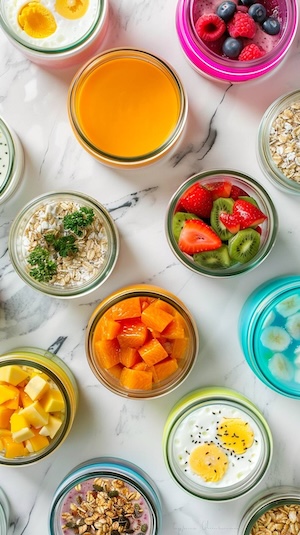Best Cereal for PCOS: Brands Ranked & Reviewed
Discover the best cereal for PCOS with our expert rankings. Compare brands, check ingredients, and find PCOS friendly cereal that supports hormonal balance.
This recipe includes superfoods such as:
Transform your health with tailored 7-day meal plans designed specifically for PCOS management. Just $7/month or $59/year.
Get it now →4 tablespoons unsalted butter
2 ounces bittersweet chocolate, coarsely chopped
1/4 cup sugar
1 large egg, lightly beaten
1/4 cup all-purpose flour
1/2 teaspoon baking powder
1/8 teaspoon salt
1/4 cup finely chopped walnuts
Preheat the oven to 325 °. Lightly butter a 9-inch springform pan. In a medium saucepan, melt the butter with the chopped chocolate over low heat, stirring constantly. Remove the melted chocolate mixture from the heat and let it cool slightly, then stir in the sugar and the lightly beaten egg until blended.
In a small bowl, whisk the flour with the baking powder and salt. Add the dry ingredients to the melted chocolate mixture. Stir the chopped walnuts into the brownie batter. Spread the batter in the prepared springform pan and smooth the surface with a spatula. Bake for 10 minutes, or until risen and dry to the touch. Let cool completely. Wrap the outside of the pan in a large sheet of foil. Leave the oven on.
In a medium glass bowl, melt the chopped chocolate in a microwave oven on high for about 1 minute, stirring halfway through. In a large bowl, using an electric mixer, beat the cream cheese until smooth. Add the sugar and beat until light and fluffy. Add the eggs, 1 at a time, beating well between additions. Beat in the cornstarch and vanilla. Add 1 cup of the cheesecake batter to the melted chocolate and stir until well blended. Beat the pumpkin puree and the cinnamon, nutmeg and cloves into the remaining cheesecake batter.
Pour three-fourths of the pumpkin cheesecake batter over the brownie crust. Pour the chocolate batter on top of the pumpkin cheesecake batter. If the chocolate batter is too thick to pour easily, heat it in a microwave oven on high for 10 seconds. Spoon the remaining pumpkin cheesecake batter on top of the chocolate batter. Use a table knife to make a few decorative swirls: Do not overswirl.
Set the springform pan in a medium roasting pan. Add enough hot water to the roasting pan to reach halfway up the side of the springform pan. Bake the pumpkin cheesecake in the hot water bath in the center of the oven for 1 1/2 hours, or until it is firm around the edges but slightly jiggly in the center. Turn the oven off, prop the door several inches open and let the cheesecake stand in the water bath in the warm oven for 1 hour, or until it is completely set.
Remove the marbled pumpkin cheesecake from the water bath and refrigerate it until thoroughly chilled, at least 4 hours or overnight. Remove the foil and springform pan ring from the cheesecake. Carefully transfer the cheesecake to a platter, cut into wedges and serve.

You know the drill: Alarm goes off. You hit snooze. Rush around frantically. Skip breakfast AGAIN because there's no time. By 10am, you're hangry, your blood sugar is all over the place, and your PCOS symptoms are already acting up.
Sound familiar?
Finally – a meal prep system designed specifically for women with PCOS who refuse to let chaotic mornings derail their health goals.
In just ONE hour on Sunday, you can transform your entire week:
"I went from skipping breakfast 4 days a week to having delicious, hormone-supporting meals ready every morning. My energy is more stable and my cravings have disappeared!"
– Sarah M.
Stop letting chaotic mornings control your health.
Get your hormone-happy mornings starting this Sunday.
→ Get Your 60-Minute Solution Now
Transform your health with tailored 7-day meal plans designed specifically for PCOS management. Just $7/month or $59/year.
Get it now →Serving Size: 12
| Amount Per ONE Serving | ||
|---|---|---|
| Calories 0 kcal | ||
| Fat 0 g | ||
| Carbohydrate 0 g | ||
| Protein 0 g | ||
💡 Introducing the 10/10 PCOS Solution:
Ten Delicious Crockpot Recipes that take just 10 minutes to prep!
Say goodbye to hours in the kitchen and hello to clean, PCOS-friendly meals made effortlessly.
👉 Click here to grab your 10/10 PCOS Solution today! Try The 10/10 PCOS Solution: Ten Crockpot Recipes That Take Just Ten Minutes to Prep
Managing PCOS can be challenging, but you don't have to do it alone. Join our supportive community to connect with others who understand what you're going through, share tips, and get encouragement. Here's how you can get involved:
Subscribe to our Newsletter: Receive PCOS-friendly recipes, tips, research updates, and more delivered straight to your inbox. Stay informed and empowered with the latest information and support.
Join our Telegram Channel: Stay updated with the latest tips and advice on managing PCOS.
Follow PCOS Meal Planner on Facebook: Engage with our community, participate in discussions, and get support from others.
Break the cycle with the PCOS Meal Planner - your personalized guide to eating better, feeling better, and managing PCOS symptoms. Take control today!

Forget the frustrating cycle of weight loss attempts, endless medications, and living in discomfort. Introducing the PCOS Meal Planner. A meal planning guide that goes beyond temporary fixes to offer a comprehensive strategy, empowering you to ignite a transformation towards lasting health and happiness. Step into a world where you control your PCOS, not the other way around.
Unlock Your PCOS Freedom Now.
Discover the best cereal for PCOS with our expert rankings. Compare brands, check ingredients, and find PCOS friendly cereal that supports hormonal balance.
Learn how to transition away from fruit when starting a ketogenic diet for PCOS. Discover gradual strategies, fruit alternatives, and practical tips for success.
Discover 5 delicious PCOS banana bread recipes with low-glycemic ingredients. Learn how to make hormone-friendly banana bread that supports blood sugar balance.
Creatine for women with PCOS explained simply. Learn safety, benefits, hormone effects, tips, and how creatine may support PCOS symptoms naturally.
Complete PCOS diet plan with foods to eat, foods to avoid, meal timing, and real results. Learn the science-backed approach to managing PCOS through diet, with 7-day meal plan, grocery list, and step-by-step implementation guide. Based on clinical research and real patient outcomes.
Complete guide to ordering at Wendy's with PCOS. Discover the best protein-focused meals, what to skip, and how to customize orders to keep blood sugar stable. Learn which burgers, salads, and sides work for PCOS, plus complete macros for every menu item and smart swaps to avoid insulin spikes.
Complete guide to ordering at Burger King with PCOS. Discover the best protein-focused meals, what to skip, and how to customize orders to keep blood sugar stable. Learn which burgers, salads, and sides work for PCOS, plus complete macros for every menu item and smart swaps to avoid insulin spikes.
Discover 30+ delicious PCOS-friendly smoothie recipes that stabilize blood sugar and support hormones. Each recipe includes protein macros, glycemic load, and hormone-balancing ingredients. Find breakfast smoothies, post-workout options, green smoothies, and dessert alternatives - all designed to prevent insulin spikes while satisfying cravings.
Discover the best supplements for PCOS backed by clinical research. Learn which supplements improve insulin resistance, reduce androgens, support ovulation, and balance hormones. Complete guide with dosages, timing, brands, and what to avoid. Evidence-based recommendations for inositol, vitamin D, omega-3, berberine, and more.